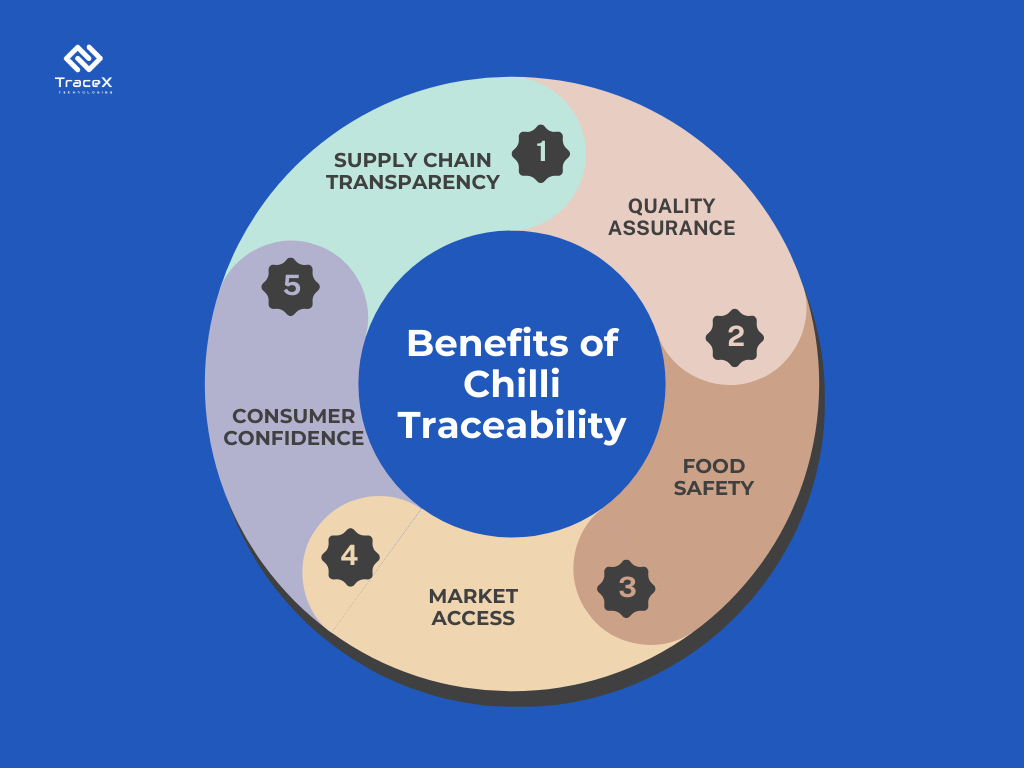Contact: +91 99725 24322 |
Menu
Menu
Quick summary: Explore the intricate dynamics of the global chilli value chain in our comprehensive blog. Delve into the cultivation, trade, and processing of chillies, and uncover the challenges and opportunities present in this dynamic industry.

Chilli peppers – those fiery delights that add a kick to our meals – have a fascinating journey from farm to table. But have you ever wondered how these little powerhouses get from seed to spice rack? The answer lies in a complex web of actors and processes – the chilli value chain.
Traceability in the chilli supply chain is paramount for ensuring food safety, quality assurance, and sustainability. With increasing consumer demand for transparency and accountability, traceability systems play a crucial role in tracking the journey of chilli from farm to fork. By implementing robust traceability measures, stakeholders can effectively monitor each step of the production process, identify potential risks or contaminants, and respond promptly to any issues that may arise. Chilli traceability thus plays an important role in protecting public health and instilling trust in the food chain.
The global chili market is characterized by significant production, consumption, and trade, with chili being one of the most widely used spices worldwide. Chili is cultivated across various regions, with major producers including India, China, Mexico, and Thailand. The demand for chili is driven by its versatile culinary applications, including seasoning, sauces, and condiments, as well as its use in pharmaceuticals and cosmetics. The market is influenced by factors such as changing consumer preferences, dietary trends, and the increasing popularity of spicy cuisine globally. Additionally, chili trade is significant, with countries importing and exporting chili products to meet domestic demand and capitalize on international market opportunities. Overall, the global chili market is dynamic and diverse, offering opportunities for producers, processors, traders, and consumers alike.
India, known as the “Land of Spices,” holds the title of being the foremost producer and exporter of chillies globally. It boasts the largest cultivation area and is both the largest producer and consumer of dry chillies worldwide. Dry chillies rank among the most widely cultivated spices in India.
The initial cultivation and harvesting operations include choosing the suitable chilli kinds, preparing the soil, planting seeds or seedlings, and executing appropriate cultivation measures like irrigation and insect control. Harvesting usually occurs when chilies reach their peak maturity, and it requires precise plucking to assure quality and minimise damage.
The processing and packaging processes begin with cleaning and sorting the harvested chilies, which are then processed using methods such as drying, grinding, or preservation. These methods attempt to improve flavour, texture, and shelf life while adhering to hygienic regulations. Packaging entails selecting appropriate materials and labelling products with critical information like expiration dates and batch numbers to aid traceability and consumer communication.
Distribution and retailing include delivering packaged chilli products to wholesalers, retailers, and straight to customers. Proper handling, storage, and transportation conditions are critical for maintaining product quality and safety during distribution. To match consumer expectations and develop trust in the supply chain, retailers must display chilli items attractively, provide correct product information, and ensure compliance with food safety requirements.
The intermediaries involved in the chilli supply chain are:
Producers play a crucial role in marketing by conducting essential practices such as drying, cleaning, grading, and packing, which significantly impact the value chain. These practices directly influence the price of the produce, which is the ultimate objective of any marketing endeavor. Chilli farmers bring their produce to market only after meticulously drying, grading, and packing them in gunny bags.
Licensed commission agents operate within regulated markets, charging a 2% commission from farmers for their services. They facilitate the trade process by fostering a competitive environment among traders, wholesalers, and processors during price negotiations. While they do not directly engage in trading, commission agents play a crucial role in facilitating trade transactions.
Traders and exporters act as intermediaries in the chili trade, purchasing produce on behalf of wholesalers, exporters, and processors. Their role is pivotal as they ensure a consistent supply of chili throughout the year, requiring cold storage facilities to preserve quality. These intermediaries procure produce based on in-person orders, storing them in nearby cold storage facilities to maintain freshness and meet market demand year-round.
Wholesalers are key players in the chili trade, purchasing large quantities of produce and distributing them in bulk to retailers. While local wholesalers actively participate, those from distant areas rely on traders for procurement due to storage constraints, as they lack cold storage facilities and are dispersed geographically.
Processors are pivotal in the chili value chain, particularly in value addition processes like chili powder production. While Kurnool hosts mainly small-scale processors focusing on powder production, larger corporations such as Priya Foods Ltd, ITC, and MTR also operate, often sourcing directly from farmers or through regulated markets during shortages. Processors in remote areas typically rely on traders to procure chili, ensuring specific quality standards and handling tasks like cleaning, grading, and transportation to the processing facilities, offering convenience to both parties.
Retailers serve as intermediaries between wholesalers, processors, and consumers, receiving chili products in bulk and distributing them in smaller quantities to end consumers across the country. With their widespread presence, retailers act as the primary touchpoint for consumers in accessing chili and chili powder products.
Despite its status as the world’s largest chilli producer, the Indian chilli industry faces a significant challenge in generating substantial trade value. This challenge stems from a lack of awareness about quality standards and reliance on traditional processes, leading to manual errors, insufficient quality production, food loss, unfair trade practices, and human biases in the chilli supply chain.
Discover how traceability solutions revolutionize the spice value chain, ensuring authenticity, quality, and sustainability every step of the way.
Unlock the Secrets of Spice Traceability!
Food safety and quality are critical in the chilli sector for protecting consumers from health concerns and maintaining the reputation of chilli products. Implementing stringent quality control procedures across the supply chain, from cultivation to distribution, helps to avoid contamination, adulteration, and other dangers, ensuring that only safe and high-quality chilies reach the market.
Chilli producers and distributors must meet regulatory requirements and obtain certificates to indicate compliance with food safety standards and laws. Obtaining certifications such as ISO, HACCP, or GMP informs customers and stakeholders that chilli goods follow industry best practices and legal criteria, hence increasing trust and simplifying market access.
Building consumer trust and confidence requires transparent methods, credible information, and consistent product quality. Chilli businesses can boost brand reputation and loyalty by prioritising food safety, following regulations, and maintaining open communication with customers.

Barcode and QR code technologies are widely utilised in the food business, especially the chilli sector, to provide for effective product tracking and traceability. These systems contain information like as batch numbers, manufacture dates, and origin, allowing stakeholders to rapidly access precise chilli product data via scanners or mobile devices.
Blockchain technology provides a decentralised and immutable ledger system that can transform chilli traceability. Each transaction or event in the chilli supply chain, from farming to sale, is securely and transparently recorded across several nodes, resulting in an immutable record of product history.
RFID tags and IoT devices provide real-time monitoring and tracking in the chilli industry. RFID tags implanted in chilli packaging or containers contain unique IDs that can be read remotely, allowing for accurate inventory management, temperature monitoring, and quality control across the supply chain.
Blockchain traceability solutions from TraceX bring transparency to the chili value chain by creating an immutable and transparent record of every transaction and movement of chili products. Each step, from cultivation to processing to distribution, is recorded on the blockchain, providing a clear and auditable history of the chili’s journey. This transparency helps to build trust among stakeholders by ensuring the authenticity and quality of chili products. Additionally, consumers can access this information, empowering them to make informed choices about the products they purchase. Furthermore, blockchain traceability reduces the risk of fraud and counterfeiting by enabling quick identification of any discrepancies or anomalies in the supply chain. Overall, TraceX’s blockchain traceability solutions enhance transparency, accountability, and trust throughout the chili value chain.
Emerging technologies and innovations are transforming industrial traceability, providing new tools and techniques for increasing supply chain transparency and accountability. Blockchain technology, Internet of Things (IoT) devices, and artificial intelligence (AI) are being used to build strong traceability systems for chilli products. For example, blockchain ensures unchangeable records of chilli transactions, whereas IoT devices track environmental conditions throughout shipment.
Chilli traceability efforts have considerable potential for worldwide standardisation and collaboration. Establishing standardised traceability standards and protocols across countries and markets can help to expedite procedures, improve interoperability across systems, and increase transparency throughout the chilli supply chain. Governments, industry stakeholders, and international organisations can work together to establish and implement standard traceability frameworks that are consistent and compatible in traceability practices worldwide.
To summarise, the chilli business is undergoing a fundamental revolution, fueled by cutting-edge technologies and joint initiatives towards worldwide standardisation. Blockchain, IoT, and AI technologies are revolutionising traceability, ensuring safety, quality, and transparency. Stakeholders may reduce risks, increase consumer trust, and strengthen the chilli supply chain by adopting a consistent approach to standards and regulations. Embracing these advances is critical to overcome obstacles and maintaining the integrity of chilli goods worldwide. As we navigate this dynamic terrain, prioritising traceability programmes is critical to protecting consumer health and building a resilient chilli business for future generations.
